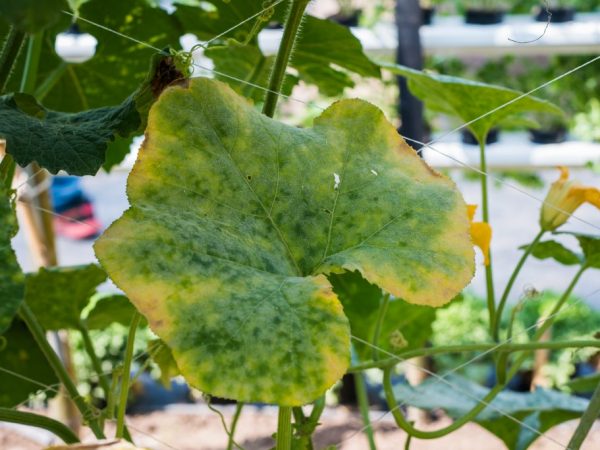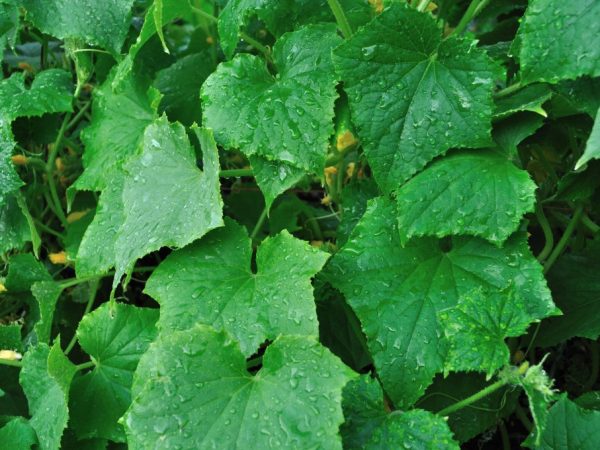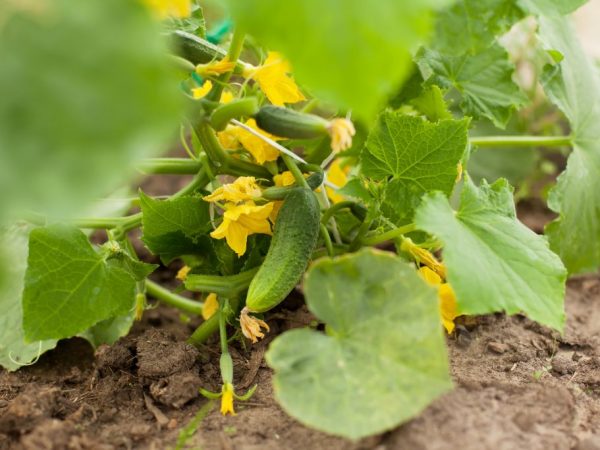Rules for processing cucumbers for diseases
Cucumbers are a vegetable crop that is very demanding on temperature conditions, watering, and is easily affected by fungal and viral diseases. They, in turn, shorten the growing season, affect the quantity and quality of the crop. Preventive treatment of cucumbers for diseases, timely diagnosis and treatment will help to avoid losses.

Rules for processing cucumbers for diseases
You need to start by identifying the symptoms that correspond to a specific disease. Then - choose the most effective drug and carry out the treatment. In addition to the more or less toxic compounds produced by the chemical industry, there are many folk remedies for the treatment of cucumbers. Let's get acquainted with the main diseases of culture and ways of dealing with them.
Powdery mildew
Signs
The disease most often develops in cloudy, cool weather. The first signs are white spots on the leaves that look like flour. Over time, their number increases, they merge, affecting the entire leaf. Ultimately, the leaves dry out, the lashes stop growing and bearing fruit.
Powdery mildew affects plants that receive nitrogen in excess and experience a moisture deficit. You can prevent the development of the disease by eliminating the favorable conditions. Helps to prevent powdery mildew damage by correct crop rotation, destruction of plant residues.
Prevention and treatment
Treatment of cucumber shoots with Topaz is effective at the initial stage of the disease. This systemic fungicide is also used for prophylaxis at the beginning of the growing season. It has the following advantages:
- quickly absorbed by plants, so there is no risk of washing off;
- has a high speed and duration of action: it affects the pathogen within 2-3 hours and retains the therapeutic effect for 2-2.5 weeks;
- well tolerated by most horticultural crops;
- small consumption rates.
Topaz is used in the treatment of other diseases: fruit and gray rot, rust, purple spot, etc.
To prepare the working solution, the contents of the ampoule (2 ml) are dissolved in 10 liters of water. How much to spend depends on the phase of plant development and the degree of disease damage. One ampoule is enough on average to process 1 weave.
Downy mildew
Signs
The defeat of the plant by peronosporosis (downy mildew) is evidenced by the appearance of a large number of light yellow spots that have an oily surface. A plaque forms on the reverse side of the sheet plate. Then the leaves turn yellow, acquire a brown tint and dry out. The buds and flowers turn black and fall off.
Like other fungal diseases, peronosporosis often appears after rain. Watering cucumber beds with cold water can provoke it. The disease can destroy the bush in a week. The disease spreads very quickly in the greenhouse.
Prevention and treatment
Heat treatment of seedling trays is carried out. Cucumber seeds must be pickled (you can use Epin), planting is carried out in disinfected soil. If you do not allow:
- sudden changes in temperature;
- waterlogging of the air and moisture on the leaves;
- thickening of landings
- and watering cucumbers with warm water, then the risk of developing downy mildew will be minimized.
Fungicides, for example, Ridomil, have a good prophylactic and therapeutic effect. Cucumbers and soil are treated with soap and soda solution. For treatment, the procedure is repeated several times with an interval of 7 days. Before spraying, it is imperative to remove and burn damaged leaves, shoots, otherwise the effect of the use of drugs will be reduced to zero.
Gray rot
Signs

If you follow the rules of care, damage to rot can be avoided
The infection affects all parts of the plant: roots, leaves, stems, flowers, fruits are covered with brown spots with a gray bloom containing spores. They are carried by the wind to neighboring bushes and beds. The danger of gray rot is that it quickly spreads among vegetables, berry crops, and garden plants.
Treatment
In addition to observing crop rotation and the basic rules for caring for cucumbers, in order to avoid damage to gray mold, it is necessary to spray with fungicides (Fitosporin, 1% solution of Bordeaux liquid), a solution prepared from 1 glass of ash, 1 glass of chalk, 1 tsp. copper sulfate and 10 liters of water.
Fusarium
Signs
The disease is caused by fungi that affect the entire plant. The leaves begin to wither. The bush can die if you do not take action. The danger of fusarium is that it cannot be diagnosed immediately. Seeds or seedlings may be contaminated. The disease manifests itself during flowering and fruiting. The sooner it is discovered, the less harm it can do.
It is possible to establish that a cucumber bush is sick with fusarium by a cross section. If the vessels of the leaf, stem are affected, they acquire a brown color. As soon as the first signs of wilting appear, such a diagnosis is carried out. After that, they immediately begin treatment.
Prevention and treatment
Start by preparing the seeds. Gardeners speak well of Fundazole, Previkur. Two days before planting seedlings, the soil is treated with biological products. After you need to spray the seedlings:
- biologics Trichodermin, Baktofit, Trichophyte are suitable;
- to increase immunity, seeds and seedlings are treated with Humisol;
- at the initial stage of the disease, the drugs Quadris, Gymnast, Acrobat are used.
A solution of whey with the addition of copper sulfate also helps (for 10 liters of water, 4 liters of whey and 1.5 tsp. Vitriol).
Cucumber pests and control
Pests are often the cause of cucumber leaves turning yellow, stained and dry. Most often, the culture is affected by aphids, spider mites, whiteflies. Pests can become carriers of dangerous diseases of vegetable crops.
Aphids and mites settle on the back of the leaf. They pierce the tissues of the plant and feed on its juices, as a result of which the described symptoms appear. A barely noticeable cobweb testifies to the defeat of cucumber bushes by a tick. The sizes of insects are very small: aphids - up to 2 mm, mites - 0.5 mm. You can recognize the appearance of the whitefly by the dark spots on the leaves: it secretes sugary substances on which sooty mushrooms settle.
The appearance of pests can be prevented if weeds are destroyed in a timely manner, the soil is disinfected in the spring, before sowing seeds or planting seedlings. Pest larvae overwinter in plant debris.
For the prevention and control of insects, cucumbers need to be treated several times with insecticides: Fufanon, Intavir (Inta-Vir), Aktara, Bi-58. It has been established that pests can become addicted to the active substance, therefore, it is advisable to change the preparations for repeated treatments.
Traditional methods
Homemade fungicides

Folk remedies for processing are safe for humans
Manufactured fungicides can be hazardous to plants, insects, animals and humans. The use of pharmaceutical preparations and "home" remedies is becoming more and more popular.
Folk remedies
How to treat cucumbers for diseases:
- mullein infusion (1 kg per 3 liters of water, hold for 3 days, strain, add another 3 liters of water);
- sour milk (mixed with water 1: 1);
- baking soda with laundry soap (50 g are diluted in 10 liters of warm water).
Processing is carried out at least 2-3 times with an interval of 1 week.
Furacilin
Gardeners share their experience of preventive and therapeutic spraying with furacilin. An inexpensive drug, which is used to gargle, treat wounds, will help to cope with powdery mildew. To do this, cucumbers must be treated with a solution prepared from 10 tablets and 2 liters of hot water (the tablets dissolve poorly in cold water). For prophylaxis, you can take 10 liters of water for such a number of tablets.
Metronidazole
In the fight against different types of bacterial and fungal diseases of cucumbers, spraying with Metronidazole (analogue of Trichopolum) will help. Preventive treatments are carried out with a preparation prepared from 1 g of trichopolum (4 tablets) and 10 liters of warm water (some gardeners add a bottle of brilliant green). For treatment, the concentration is tripled: 3 g (12 tablets). It is necessary to process so that the liquid penetrates into the affected areas. For root watering, a less concentrated solution is also suitable.
Garlic
Many owners, instead of insecticides, use folk remedies for pest control. Cucumbers are processed with garlic. The tincture is prepared as follows:
- the cloves are crushed;
- poured with water in a ratio of 1: 1;
- I insist in a dark place for 7-10 days.
To spray cucumbers, take 50 ml of tincture per bucket of water. For better adhesion, add laundry soap or detergent. Treating cucumber beds with garlic will also help against fungal diseases.
Connoisseurs recommend spraying with tar soap, which itself has deterrent properties.
Conclusion
One of the most common questions that gardeners have is how to effectively process cucumbers if the foliage has turned yellow? You need to start by establishing the cause: what disease or pest caused the symptom. Only then should appropriate measures be taken.
The trading network offers many drugs for the treatment of cucumbers. You can choose industrial-made fungicides and insecticides, or use folk methods. You need to take care of the health of vegetable beds long before planting, paying due attention to preventive measures.


